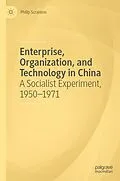Given the near-silence in technological and business history about post-World War II socialist enterprises, this book gives voice to a generation of Communist China's managers, entrepreneurs, cadres, and workers from the Liberation to the early 1970s. Using recently-opened online archival resources, it details and assesses the course of technical and organizational experimentation at state-owned, cooperative, and private enterprises as the PRC strove to construct a socialist economy through trial-and-error initiatives. Core questions treated are: How did Chinese enterprises operate, evolve, experiment, improvise and adjust during the PRC's first generation? What technological initiatives were crucial to these processes, necessarily developed with limited expertise and thin financial resources? How could constructing "socialism with Chinese characteristics" have helped lay foundations for the post-1980 "Chinese miracle," as the PRC confidently entered the 21st centurywhile Soviet and Central European socialisms crumbled? And what might current-day Western managers and entrepreneurs learn from Chinese practice and performance a half-century ago?
Readers can anticipate a granular, bottom-up analysis of how businesses worked day-to-day in a planned economy, how enterprise practices and technological strategies shifted during the first postwar generation, how managers and technicians emerged after the capitalist exodus, how organizations experimented and adapted, and how the controversies and convulsions of the PRC's early decades fashioned durable technical and organizational capabilities.
Autorentext
Philip Scranton is Board of Governors Professor Emeritus, History of Industry and Technology, at Rutgers University. His publications include eighteen books and over eighty scholarly articles.
Inhalt
Chapter 1 Introduction
Part I: Business Practices from Liberation through the Great Stumble, 1949-1961
Chapter 2. Agriculture: Organization for Self-reliance
Chapter 3. Infrastructure as Labor Intensive Development
3.1 Centrally-sponsored Construction, 1950-1957
3.2 The Organization of State Construction
3.3 The Small and the Local
3.4 Cement, Floods, and Infrastructure
Chapter 4. Commerce and Socialist Construction
4.1 Urban and Rural Commerce in the 1950s
4.2 Markets and Bending the Rules
4.3 Commercial Reform, The Great Leap and Communalization
4.4 Recovery and Creativity
4.5 Commerce Supports Agriculture
Chapter 5. Industry: From Trial-and-Error to Technology Reform
5.1 Managerial Challenges in the Early 1950s
5.2 Industrial Investments and Industrial Troubles
5.3 Manufacturing's Great Leap
5.4 Technical Reform and Technological Revolution
5.5 Industry Supporting Agriculture
Part Two: Recovery, Reversal, Resilience: Business Practices, 1962-1971
Chapter 6. Agriculture as the Foundation
6.1 The Four Modernizations and the Four Magic Wands
6.2 Upgrading Agriculture By Refocusing Industry
6.3 Industry Again Supports Agriculture
6.4 Intensification and Diversification a Closing Note
Chapter 7. Infrastructure: Reappraisal and Reorientation
7.1 Consolidating Railroad Practice
7.2 Roadbuilding and Maintenance
7.3 Electrification
&nbs...
